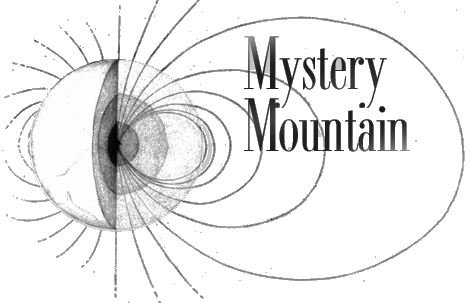

In an ancient lava flow geologists have discovered signs of strange magnetic behavior that may lead to a new understanding of the Earth's interior.
By LOU BERGERON
Illustrations by Kirsten Carlson
OUT ON THE BROAD, SUNBAKED PLAINS of southeastern Oregon, Steens Mountain looms on the horizon like a giant stone battleship becalmed on a vast, placid sea. Sixteen million years ago, a series of immense flows of lava gushed forth across those plains. Erosion has since claimed most of the lava flows, but the mountain remains, stretching 60 miles from north to south. Massive lava flows are common historically, but Steens Mountain contains geologic oddities so unexpected that they may profoundly alter our perception of the inner workings of our planet.
In the center of the Earth sits a dense core of nickel and iron, roughly 2,000 miles in diameter. Geophysicists, who study the Earth's interior, believe the inner core to be solid and the outer core fluid. A layer of solid rock 1,800 miles thick called the mantle surrounds the outer core. Atop the mantle rests the Earth's crust, the thin layer where mountains form, and wind and water wear them down.
Geophysicists think the fluid in the outer core circulates, with currents driven by gravitational and thermal forces interacting with the Earth's rotation. The currents are thought to travel roughly six to twenty miles per year.
This circulation in the iron-rich outer core generates the global magnetic field, the helpful force that guides not only compass needles but also, as biologists are finding, a wide variety of animals, from bacteria to seagoing turtles.
Yet the Earth's magnetic field is not as reliable as one might expect. Paleomagnetists, scientists studying the history of the magnetic field, learned 30 years ago that the polarity of the field occasionally reverses. If the field were reversed now, compasses would point south instead of north. Many scientists believed that these reversals happened slowly, in a series of short steps, taking roughly 5,500 years. But the rocks in Steens Mountain record episodes when the field was moving up to six degrees in a single day, a burst of speed over 1,000 times faster than expected. How the relatively slow-moving fluid in the outer core can generate such rapid changes is a mystery.
A field fluctuating with the speed suggested by Steens Mountain would not only force geophysicists to reevaluate ideas about the Earth's interior, but could also affect animal migrations.
 Although the mechanism generating the Earth's magnetic field is still not
fully understood, the field can be pictured as a tiny, immensely powerful bar
magnet at the center of the planet, tilted about eleven and a half degrees from
the rotational axis. Lines of magnetic force flow out into space from one end
of the magnet, curve around the Earth, then return to the other end of the
magnet, like greatly exaggerated lines of longitude running from pole to pole
on a globe. A magnet dangling freely from a string at the Earth's surface will
align itself along those lines of force.
Although the mechanism generating the Earth's magnetic field is still not
fully understood, the field can be pictured as a tiny, immensely powerful bar
magnet at the center of the planet, tilted about eleven and a half degrees from
the rotational axis. Lines of magnetic force flow out into space from one end
of the magnet, curve around the Earth, then return to the other end of the
magnet, like greatly exaggerated lines of longitude running from pole to pole
on a globe. A magnet dangling freely from a string at the Earth's surface will
align itself along those lines of force.
Likewise, when volcanic lava that has erupted out of the Earth's interior cools, atoms of iron in the lava move into alignment with the lines of force of the magnetic field. More precisely, when the temperature of the solidified lava falls to 580 degrees C, the atoms are "frozen" into position, preserving a record in the rock of the orientation of the geomagnetic field at the time of the eruption. Normally, a single lava flow records a single orientation of the field, but in Steens Mountain two flows each record a continuous range of orientations that show the field changing 60 degrees in the estimated ten days each flow took to cool.
Rob Coe, a professor of Earth Sciences at the University of California at Santa Cruz, and French paleomagnetist Michel Prevot first reported these findings in 1989. Although the two episodes are part of a full reversal which still took about 5,000 years, the sudden field changes reported were so astounding that other researchers greeted them with deep skepticism. Coe and Prevot have since analyzed well over a hundred samples from Steens Mountain, and the additional data support their initial findings.
Pierre Camps, a post-doctoral researcher from France studying paleomagnetism with Coe at UC Santa Cruz, is helping to test the evidence in the rocks at Steens Mountain. Last summer, accompanying Coe and Prevot on the mountain, he edged his way carefully across steep cliffs to sample the volcanic rock many times.
Camps took his samples with a specially converted chain saw. The saw had a hollow tube, eighteen inches long and an inch in diameter, in place of the conventional bar and chain. The tube acted as a hollow drill. Its rim was encrusted with industrial diamonds that cut into the rock, allowing Camps to remove a cylindrical piece of rock about six inches long, called a core, to take back to the lab. Trying to hold the roaring, vibrating drill absolutely steady while watching one's footing on a 2,800-foot high, near-vertical cliff was "a little dangerous," said Camps.
Measuring the almost imperceptible magnetism recorded in rocks is difficult. To decode the magnetic encryptions in his rocks, Camps works tucked away in the redwoods at the edge of the UCSC campus in a specially constructed lab called a "field free" room. The building's wooden frame, fastened with aluminum nails and brass screws, is sheathed on all sides with special "transformer" steel that blocks out almost all of the present day magnetic field.
The original magnetic orientation recorded in rock is often altered by weathering or metamorphism, which can add a faint overprinting of later orientations. To remove overprinting, Camp heats the samples past the temperature at which the overprinting occurred. Time and again he inserts the cores into an oven. Each time they are heated to a slightly higher temperature, allowed to cool, and their magnetic orientation measured. Only when the same orientation is consistently measured, at temperatures over 500 degrees C, is the original orientation ascertained. The whole process requires fifteen repetitions of the sequence of heating, cooling and measuring. Each repetition takes several hours to perform. "I work a lot," says Camps.
Still more work will be required to convince skeptics that the results from Steens Mountain are valid. The unexpectedly high rate of field change is controversial, not only because it suggests that the outer core flows at speeds far in excess of predicted rates. Some geophysicists argue that even if the outer core moves that quickly, the thick mantle surrounding the core would screen out the rapid field change generated by those movements, keeping the field change from reaching the surface quickly enough to be recorded in a single lava flow.
Nevertheless, possible evidence of rapid field changes from other
locales is starting to be reported, and next summer Coe's team hopes to sample
Steens Mountain again. If those results confirm the existing data,
geophysicists may have to rethink radically their conception of the inner
workings of the Earth, whether they like it or not.
